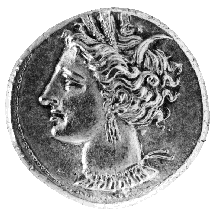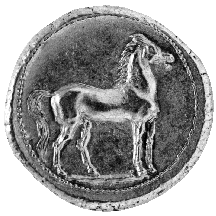



(21) Carthage, Zeugitana (Tunisia) - EL stater, 320-310
B.C., 7.60 g. (inv. 91.042).
Obverse: Head of Tanit/Demeter/Persephone l., wearing triple-drop
earring, pendant necklace, and wreath of grain.
Reverse: Standing horse r.; two pellets behind front legs.
Provenance: Ex Santa Barbara Museum of Art; Malter, 1975.
Bibliography: G.K. Jenkins and R.B. Lewis, Carthaginian
Gold and Electrum Coins (London 1963) 225.
Carthage, the important Phoenician trading city on the northern coast of
Africa, first produced silver coins in Sicily in the second half of the
fifth century for use in transactions with the Greek colonies there and
later for paying its troops attempting to gain control of the island (see
no. 20). In contrast to this Siculo-Punic coinage,
the coinage of Carthage itself begins only in the early to mid-fourth century,
its large denominations entirely gold and electrum.
The images on Carthaginian coinage, like those of the Siculo-Punic issues,
are a mixture of Greek and Carthaginian types. The head on the obverse of
this stater is usually identified as Tanit, the main deity of Carthage,
but the head is clearly based upon the head of the nymph Arethusa by Euainetos
on Syracusan dekadrachms (see no. 19). Tanit is the
Carthaginian equivalent of Juno. The head has also been identified as Demeter
or Persephone, the important agricultural goddesses of Sicily, because,
unlike Arethusa, she has ears of grain in her wreath. The cult of Demeter
and Persephone was established in Carthage in 396 B.C., in atonement for
the destruction of their temples during the Carthaginian invasion of Sicily.
The horse appears in various forms on both Carthaginian and Siculo-Punic
coins (see nos. 20, 22). It
may refer to the Carthaginian foundation legend, in which the goddess Juno
pointed out the future site of Carthage by showing the Phoenicians the spot
where they would discover a horse's head in the ground (Virgil, Aeneid
1. 441-44; see no. 20).
K.L.M.



All contents copyright (c) 1996.
Lawrence University
All rights reserved.